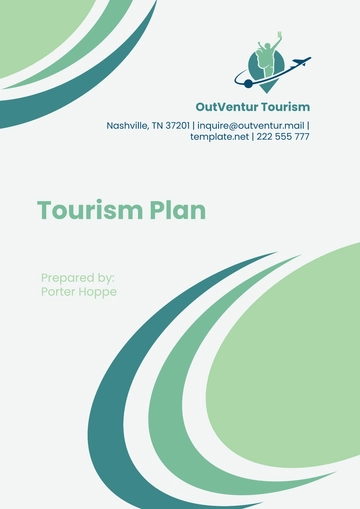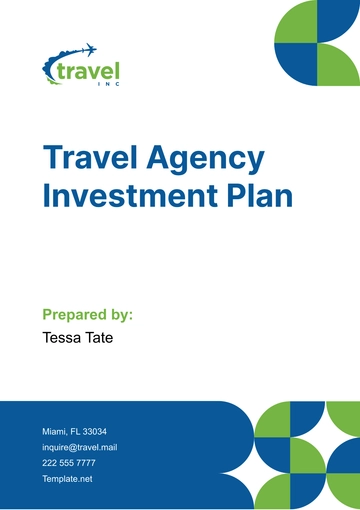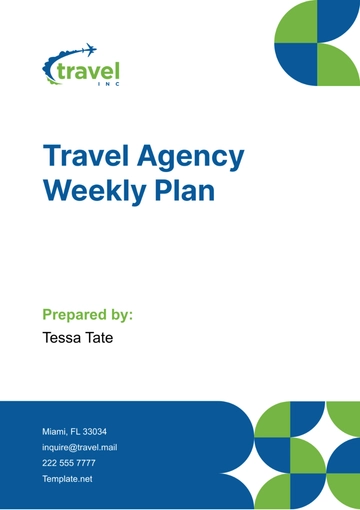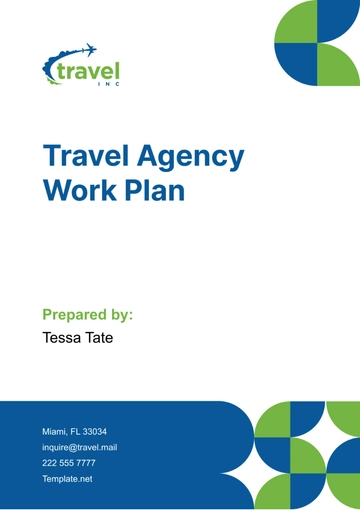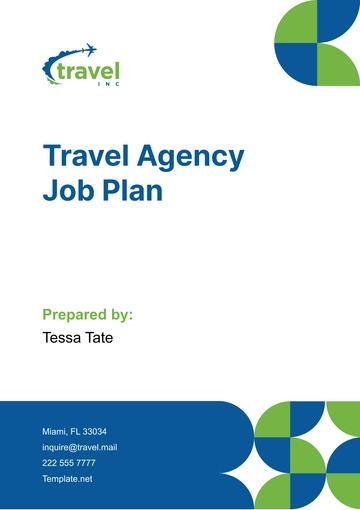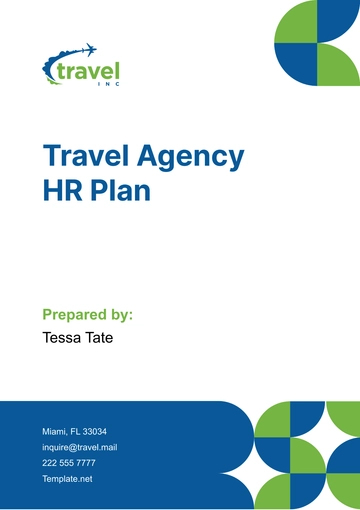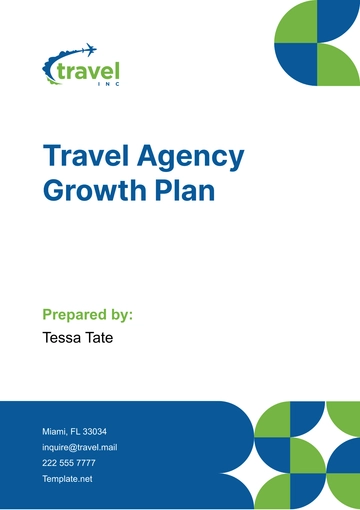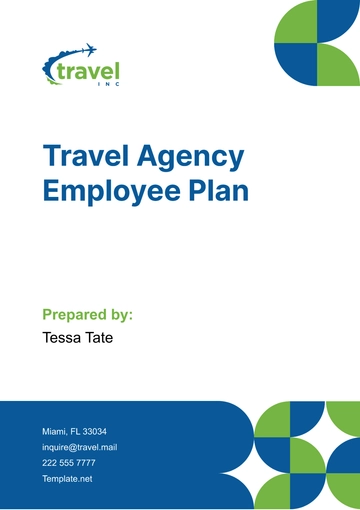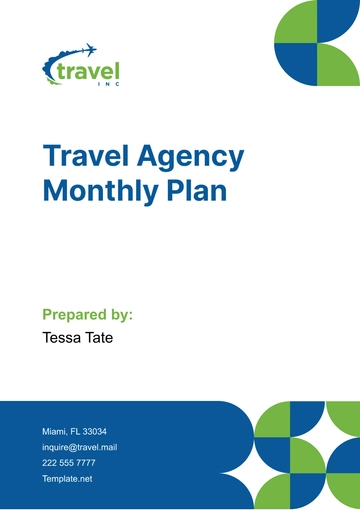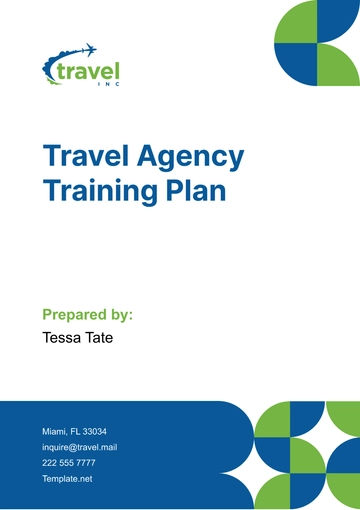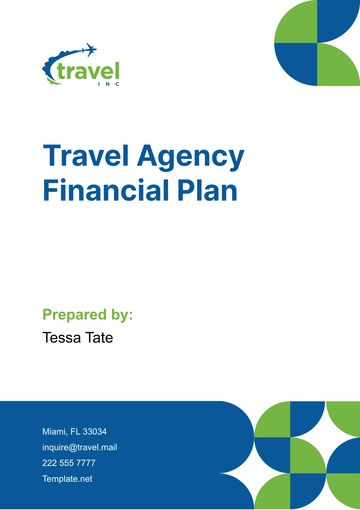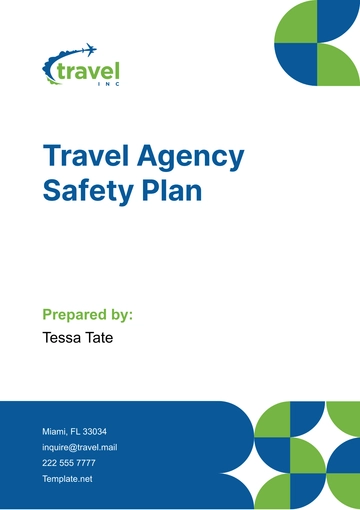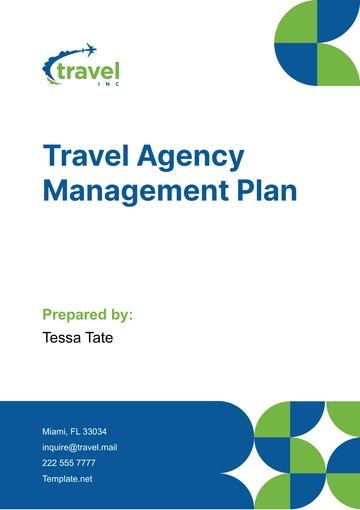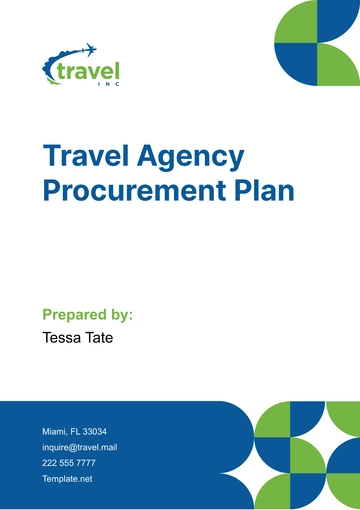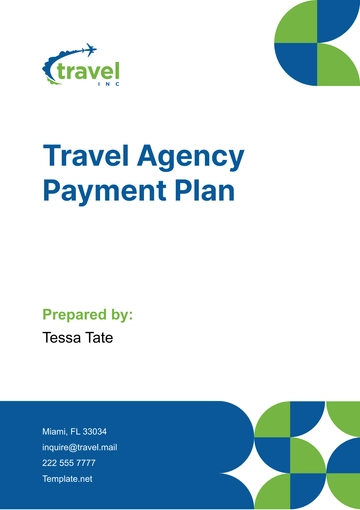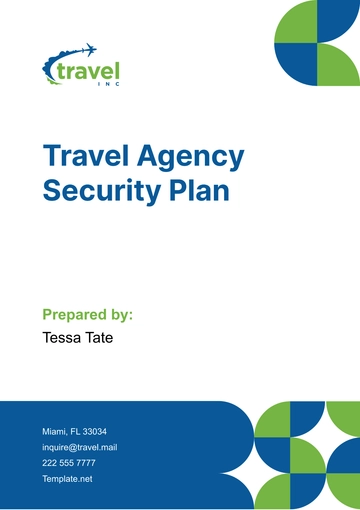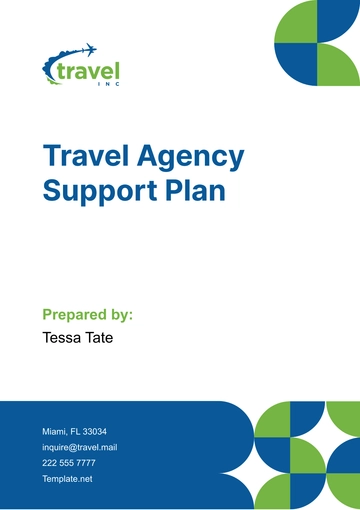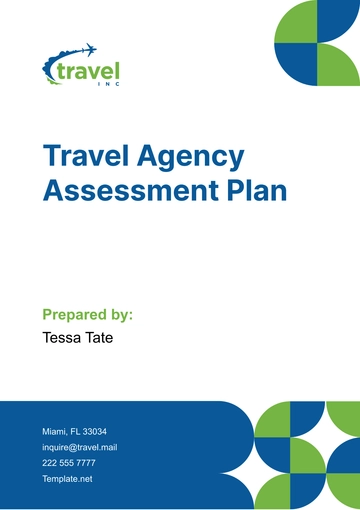Free Travel Agency Financial Plan
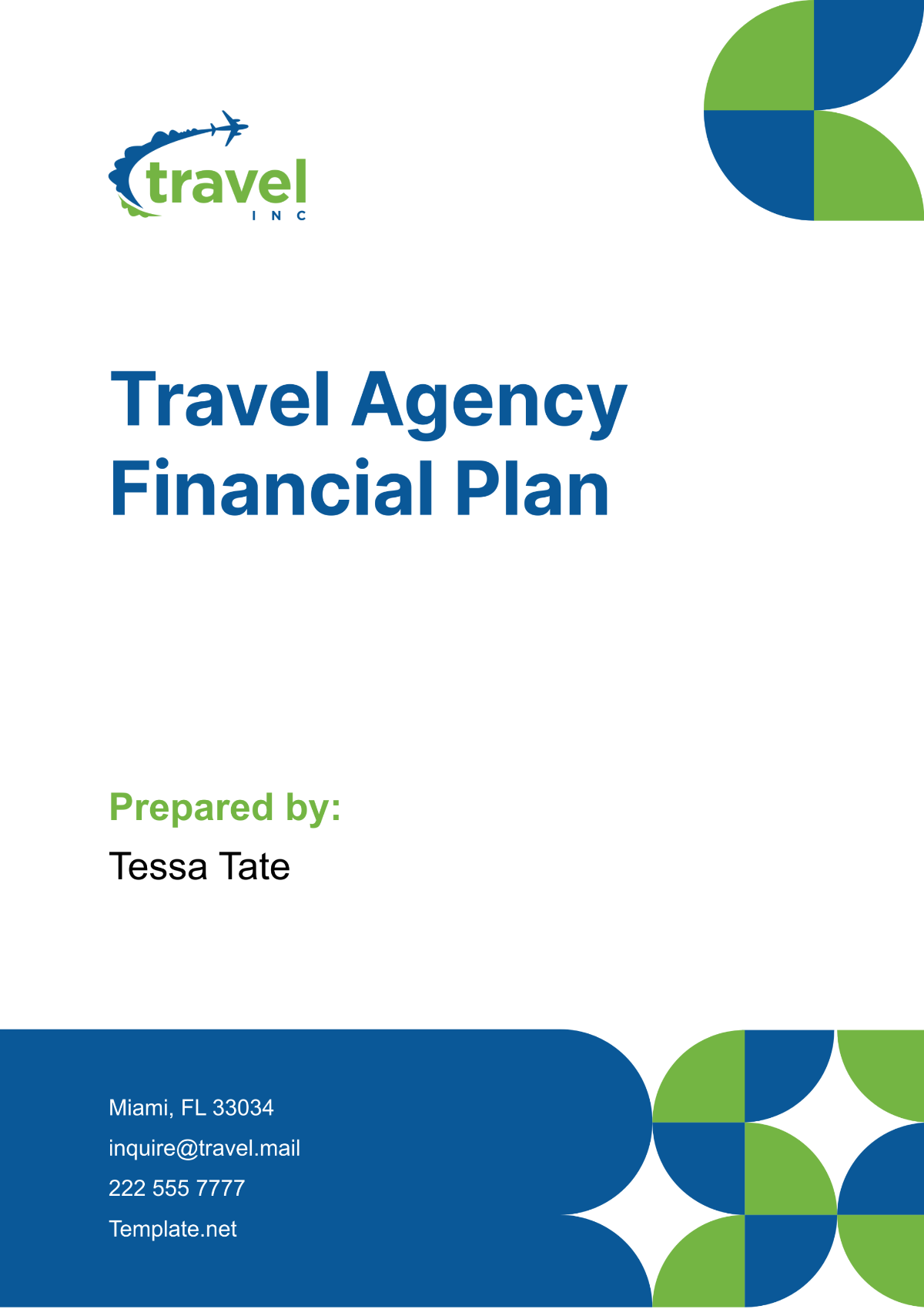
I. Executive Summary
The Travel Agency Financial Plan, designed for [Your Company Name], strategically positions the agency for robust financial health and market adaptability. It integrates sophisticated forecasting models for revenue streams and aligns them with meticulously planned expense controls. This document emphasizes investment in technology and innovative travel packages to capture diverse market segments. The primary goal is to enhance profitability while mitigating risks associated with economic uncertainties and fluctuating travel demands.
Revenue Streams: Our revenue strategy leverages multiple streams including personalized travel packages, corporate contracts, and online booking platforms. [Your Company Name] will focus on high-margin offerings, such as luxury travel and exclusive experiences, to differentiate itself in the competitive market. Regular analysis of booking trends and consumer behavior will allow for agile adjustments, ensuring continued growth and market relevance. Partnerships with
global service providers will further expand our reach and revenue potential.
Cost Management: Effective cost management is pivotal in maximizing the profitability of [Your Company Name]. This plan outlines a rigorous approach to budgeting and expenditure, focusing on cost-effective solutions without compromising the quality of travel services offered. Strategic negotiations with suppliers and careful management of operational costs will preserve financial stability. Additionally, investments in digital transformation will streamline operations and reduce long-term costs through enhanced efficiency.
Financial Goals and Projections: The financial projections for [Your Company Name] are designed to forecast growth and ensure sustainability. By the end of the next five-year period, we aim to achieve a steady increase in net profits by 15% annually, while maintaining a robust cash flow to support expansion and unforeseen market changes. This section also sets forth a contingency plan to safeguard against potential financial downturns, ensuring that the agency remains resilient in the face of challenges.
II. Revenue Forecasting
Revenue forecasting is essential for [Your Company Name]'s strategic financial planning. It enables precise predictions of future earnings, facilitating smarter decisions regarding resource distribution, investment opportunities, and strategic growth initiatives. The table below provides a detailed five-year revenue forecast, illustrating expected growth based on market analysis and historical data. This predictive insight is crucial for optimizing operational efficiency and capitalizing on market trends.
Year | Forecast Revenue | Year-over-Year Growth | Cumulative Growth |
|---|---|---|---|
Year 1 | $1.00M | 5% | 5% |
Year 2 | $1.05M | 10% | 15.5% |
Year 3 | $1.15M | 15% | 32.3% |
Year 4 | $1.32M | 20% | 58.4% |
Year 5 | $1.58M | 25% | 96.3% |
Year-over-Year Growth in percentage (%)
This forecast anticipates steady growth, with a strategic focus on expanding market presence and enhancing service offerings. Key initiatives include enhancing digital marketing efforts, diversifying travel packages, and strengthening partnerships with global service providers. The projected increases reflect our commitment to driving profitability through innovation and superior customer service.
III. Expense Management
Effective expense management is vital for maintaining the financial integrity of [Your Company Name]. This section outlines our structured approach to controlling costs through meticulous budget planning and monitoring. Below is a detailed table of projected monthly and annual expenses across key operational areas, ensuring transparency and accountability in financial operations. Regular evaluations and adjustments will be implemented to align with strategic objectives and financial forecasts.
Expense Category | Monthly Budget | Annual Budget | Notes |
|---|---|---|---|
Staffing | $20,000 | $240,000 | Includes salaries and benefits |
Marketing | $15,000 | $180,000 | Digital and traditional media |
Operations | $10,000 | $120,000 | Office and utilities |
New Product Development | $5,000 | $60,000 | Innovation and market research |
Monthly Budget in Thousands ($)
Annual Budget in Thousands ($)
IV. Investment Strategy
Proactive investment is crucial for bolstering [Your Company Name]'s market position and financial robustness. This section details our strategy to invest in diversifying service offerings, adopting advanced technology, expanding into new geographic markets, forming strategic partnerships, and pursuing acquisitions that complement our core objectives. Below is a table summarizing our key investment areas and the goals associated with each to drive growth and innovation.
Investment Area | Objective | Expected Impact |
|---|---|---|
Diversifying Service Offerings | To offer a broader range of travel options | Increase customer base and revenue streams |
Technology Advancements | To enhance operational efficiency and customer engagement | Improve service delivery and reduce costs |
Geographic Market Expansion | To enter new markets and tap into growing tourism sectors | Expand market share and global presence |
Partnerships with Travel Entities | To leverage synergies and enhance service capabilities | Broaden service portfolio and increase competitive edge |
Strategic Acquisitions | To integrate valuable assets and expertise | Strengthen market position and accelerate growth |
This investment strategy is designed to secure long-term growth and sustainability for [Your Company Name]. By focusing on these strategic areas, we aim to enhance our competitive edge and ensure financial strength in the dynamic travel industry. Each investment will be carefully evaluated for its potential return and alignment with our overarching business goals.
V. Cash Flow Management
Effective cash flow management is essential to maintain liquidity and fund operational needs and growth initiatives at [Your Company Name]. This section outlines our comprehensive strategies to enhance cash flow, including methods to accelerate receivables, optimize payment terms, maintain reserves, and utilize forecasting tools. Below is a table that highlights these strategies along with their specific goals and expected outcomes.
Strategy | Goal | Expected Outcome |
|---|---|---|
Accelerating Receivables | To shorten the cash conversion cycle | Increase cash availability and reduce delays in receivables |
Optimizing Payment Terms with Vendors | To negotiate favorable payment schedules | Improve cash flow timing and preserve working capital |
Maintaining a Cash Reserve | To provide a buffer against financial uncertainties | Enhance financial stability and readiness for unexpected expenses |
Regular Financial Health Checks | To monitor and assess the financial status regularly | Identify potential issues early and adjust strategies accordingly |
Use of Cash Flow Forecasting Tools | To predict and manage future cash flows accurately | Optimize financial planning and decision-making |
This proactive approach to cash flow management will ensure that [Your Company Name] has the financial agility to support day-to-day operations and invest in strategic growth opportunities. Regular reviews and adjustments to these strategies will be key to maintaining optimal liquidity and financial health.
VI. Dealing with Economic Fluctuations
Navigating economic fluctuations is critical for sustaining [Your Company Name]'s operational resilience and market adaptability. This section describes our strategies for monitoring economic trends and dynamically adjusting business practices. Key tactics include implementing flexible pricing, enhancing cost efficiency, and strengthening our value proposition to retain customer loyalty. Below is a table outlining these approaches and their intended impact.
Strategy | Objective | Implementation Detail |
|---|---|---|
Monitoring Economic Indicators | To stay ahead of market trends | Regular analysis of global and local economic data |
Flexible Pricing Strategies | To adjust prices based on market conditions | Use of dynamic pricing models to attract and retain customers |
Cost-Control Measures | To reduce operational expenses during low economic periods | Streamline operations and negotiate better terms with suppliers |
Reinforcing Value Proposition | To enhance customer perception and loyalty | Focus on unique travel experiences and superior customer service |
This strategic framework ensures [Your Company Name] remains proactive and responsive to economic changes, safeguarding our competitive edge and financial health. By continuously adapting to the economic environment, we aim to maintain stability and growth even during challenging times.
VII. Industry Change Adaptation
Adapting to rapid changes in the travel industry is crucial for the sustained success of [Your Company Name]. This section outlines our commitment to maintaining industry relevance through continuous assessment and agility in our business practices. Our strategies include staying informed about global trends, adopting new technologies, updating travel offerings, continuous staff training, and active participation in industry conferences. Below is a table that details these strategies and their implementation to ensure our adaptability and competitiveness.
Strategy | Objective | Implementation Detail |
|---|---|---|
Staying Updated with Global Travel Trends | To anticipate and respond to consumer demands | Regularly analyze market research and travel data |
Adopting New Technologies | To enhance operational efficiency and customer experience | Implement the latest in booking and virtual reality technologies |
Updating Travel Packages | To reflect current trends and destinations | Periodically revise offerings based on traveler feedback and trend analysis |
Continuous Staff Training | To ensure high service standards and knowledge | Provide ongoing training in customer service and emerging industry practices |
Participating in Industry Conferences | To network and gain insights into industry evolution | Attend major travel and tourism conferences globally |
This proactive approach to industry change ensures that [Your Company Name] not only keeps pace with the evolving market but also leverages these changes to enhance our service delivery and market position. By continuously innovating and adapting, we aim to provide superior travel experiences that meet the dynamic needs of our customers.
VIII. Marketing and Promotion
A robust marketing strategy is pivotal for the growth and visibility of [Your Company Name]. This section elaborates on our comprehensive approach to utilizing both digital and traditional marketing channels to attract and retain clients. We focus on optimizing SEO, enhancing social media engagement, forging strategic partnerships, and launching targeted promotional campaigns. Below is a table that details these key marketing strategies and how they will be implemented to maximize our market reach and brand recognition.
Strategy | Objective | Implementation Detail |
|---|---|---|
SEO Optimization | To improve online visibility and rankings | Regularly update website content with SEO best practices |
Social Media Engagement | To build a strong online presence and interact with customers | Actively post and engage on platforms like Instagram, Facebook, and Twitter |
Strategic Partnerships | To leverage mutual benefits with other businesses | Collaborate with local and international travel influencers and organizations |
Promotional Campaigns | To drive bookings and increase brand awareness | Launch seasonal and thematic promotions tied to popular travel destinations |
This integrated marketing strategy ensures that [Your Company Name] maintains a dynamic and engaging presence both online and offline. By effectively reaching out to new and existing customers through these diverse channels, we aim to significantly enhance our client base and overall market impact.
IX. Performance Monitoring and Reporting
For [Your Company Name], rigorous performance monitoring and reporting are key to achieving and maintaining operational excellence and financial health. This section details our approach to setting comprehensive metrics and KPIs to accurately assess the agency's performance. We will utilize monthly and quarterly reports to analyze financial and operational data, ensuring alignment with our strategic objectives. Below is a table that outlines our monitoring strategies and their purposes to keep our operations on track and dynamically responsive.
Metric/KPI | Reporting Frequency | Objective | Details |
|---|---|---|---|
Revenue Growth | Monthly, Quarterly | To track progress towards revenue targets | Compare current figures against past periods and forecasts |
Cost Management Efficiency | Quarterly | To ensure efficient use of resources | Monitor expenditure against budget and adjust as necessary |
Customer Satisfaction Index | Monthly | To gauge service quality and customer satisfaction | Collect feedback through surveys and direct customer interactions |
Operational Performance Metrics | Quarterly | To assess efficiency of operational processes | Evaluate logistics, booking processes, and staff performance |
Market Share Comparison | Annually | To evaluate competitive position in the market | Analyze market data to compare our growth against competitors |
Through this structured approach to performance monitoring and reporting, [Your Company Name] ensures that all aspects of the agency are continuously evaluated and improved upon. These measures allow us to make informed decisions swiftly, adapt strategies as necessary, and ultimately drive our long-term success.
X. Risk Management
Effective risk management is essential to safeguard [Your Company Name] from potential financial risks and operational threats. This section outlines our comprehensive approach to identifying, assessing, and mitigating risks related to operations, market conditions, credit, and compliance with international travel regulations. We will maintain a detailed risk register and develop robust mitigation plans, reviewed and updated regularly. Below is a table that details the focus areas of our risk management strategy, including the methods of mitigation and the frequency of reviews.
Risk Area | Mitigation Strategy | Review Frequency |
|---|---|---|
Operational Risks | Implementing standardized procedures and continuous training | Quarterly |
Market Volatility | Diversifying service offerings and adjusting pricing strategies as per market demand | Bi-annually |
Credit Risks | Conducting thorough credit checks and setting clear payment terms for clients | Annually |
Compliance with Travel Regulations | Staying updated with international laws and ensuring all operations are compliant | Annually and as regulations change |
This proactive risk management framework ensures that [Your Company Name] is well-prepared to handle uncertainties effectively. By regularly assessing and adjusting our strategies, we aim to minimize exposure to adverse impacts and maintain a stable, secure operational environment.
XI. Stakeholder Communication
Effective communication is crucial for maintaining strong relationships with all stakeholders of [Your Company Name], including investors, employees, partners, and clients. This section outlines our strategy to ensure continuous and transparent communication through various channels. We are committed to providing regular updates via newsletters, detailed reports, and scheduled meetings to keep all parties informed and engaged. Below is a table that details our communication methods, the stakeholders they target, and the frequency of these communications.
Stakeholder | Communication Method | Frequency | Purpose |
|---|---|---|---|
Investors | Quarterly Reports | Quarterly | To update on financial performance and strategic developments |
Employees | Internal Newsletters | Monthly | To inform about company updates, achievements, and operational changes |
Partners | Partnership Meetings | Bi-annually | To discuss collaborative efforts and opportunities for growth |
Clients | Email Updates | As needed/Post interaction | To provide travel updates and promotional offers |
This structured communication plan ensures that all stakeholders are well-informed and aligned with the goals and progress of [Your Company Name]. By fostering open lines of communication, we aim to build trust, encourage transparency, and strengthen our relationships across all levels of the organization.
XII. Conclusion
This Travel Agency Financial Plan meticulously outlines a strategic blueprint for [Your Company Name] to harness financial resources effectively and drive sustainable growth. By executing the outlined financial, operational, and risk management strategies, the agency is poised to solidify its competitive edge, respond dynamically to market and industry shifts, and reliably meet its profitability targets. The commitment to rigorous performance monitoring further ensures continuous improvement and alignment with long-term objectives.
Through the proactive implementation of this comprehensive plan, [Your Company Name] will not only navigate current market complexities but also capitalize on emerging opportunities. Strengthening stakeholder relationships through transparent communication, adapting swiftly to economic fluctuations, and focusing on innovative marketing strategies are pivotal. These efforts will collectively propel the agency towards achieving its financial aspirations and maintaining a resilient and flourishing business.
- 100% Customizable, free editor
- Access 1 Million+ Templates, photo’s & graphics
- Download or share as a template
- Click and replace photos, graphics, text, backgrounds
- Resize, crop, AI write & more
- Access advanced editor
Elevate your travel agency's financial strategy with Template.net’s Travel Agency Financial Plan Template. This editable and customizable template streamlines financial planning, ensuring precision and ease. Editable in our Ai Editor Tool, it’s designed to adapt to your specific needs, enhancing efficiency and foresight in financial management. Optimize your financial planning today to navigate the competitive travel market with confidence. Join successful entrepreneurs boosting their business savvy with Template.net.
You may also like
- Finance Plan
- Construction Plan
- Sales Plan
- Development Plan
- Career Plan
- Budget Plan
- HR Plan
- Education Plan
- Transition Plan
- Work Plan
- Training Plan
- Communication Plan
- Operation Plan
- Health And Safety Plan
- Strategy Plan
- Professional Development Plan
- Advertising Plan
- Risk Management Plan
- Restaurant Plan
- School Plan
- Nursing Home Patient Care Plan
- Nursing Care Plan
- Plan Event
- Startup Plan
- Social Media Plan
- Staffing Plan
- Annual Plan
- Content Plan
- Payment Plan
- Implementation Plan
- Hotel Plan
- Workout Plan
- Accounting Plan
- Campaign Plan
- Essay Plan
- 30 60 90 Day Plan
- Research Plan
- Recruitment Plan
- 90 Day Plan
- Quarterly Plan
- Emergency Plan
- 5 Year Plan
- Gym Plan
- Personal Plan
- IT and Software Plan
- Treatment Plan
- Real Estate Plan
- Law Firm Plan
- Healthcare Plan
- Improvement Plan
- Media Plan
- 5 Year Business Plan
- Learning Plan
- Marketing Campaign Plan
- Travel Agency Plan
- Cleaning Services Plan
- Interior Design Plan
- Performance Plan
- PR Plan
- Birth Plan
- Life Plan
- SEO Plan
- Disaster Recovery Plan
- Continuity Plan
- Launch Plan
- Legal Plan
- Behavior Plan
- Performance Improvement Plan
- Salon Plan
- Security Plan
- Security Management Plan
- Employee Development Plan
- Quality Plan
- Service Improvement Plan
- Growth Plan
- Incident Response Plan
- Basketball Plan
- Emergency Action Plan
- Product Launch Plan
- Spa Plan
- Employee Training Plan
- Data Analysis Plan
- Employee Action Plan
- Territory Plan
- Audit Plan
- Classroom Plan
- Activity Plan
- Parenting Plan
- Care Plan
- Project Execution Plan
- Exercise Plan
- Internship Plan
- Software Development Plan
- Continuous Improvement Plan
- Leave Plan
- 90 Day Sales Plan
- Advertising Agency Plan
- Employee Transition Plan
- Smart Action Plan
- Workplace Safety Plan
- Behavior Change Plan
- Contingency Plan
- Continuity of Operations Plan
- Health Plan
- Quality Control Plan
- Self Plan
- Sports Development Plan
- Change Management Plan
- Ecommerce Plan
- Personal Financial Plan
- Process Improvement Plan
- 30-60-90 Day Sales Plan
- Crisis Management Plan
- Engagement Plan
- Execution Plan
- Pandemic Plan
- Quality Assurance Plan
- Service Continuity Plan
- Agile Project Plan
- Fundraising Plan
- Job Transition Plan
- Asset Maintenance Plan
- Maintenance Plan
- Software Test Plan
- Staff Training and Development Plan
- 3 Year Plan
- Brand Activation Plan
- Release Plan
- Resource Plan
- Risk Mitigation Plan
- Teacher Plan
- 30 60 90 Day Plan for New Manager
- Food Safety Plan
- Food Truck Plan
- Hiring Plan
- Quality Management Plan
- Wellness Plan
- Behavior Intervention Plan
- Bonus Plan
- Investment Plan
- Maternity Leave Plan
- Pandemic Response Plan
- Succession Planning
- Coaching Plan
- Configuration Management Plan
- Remote Work Plan
- Self Care Plan
- Teaching Plan
- 100-Day Plan
- HACCP Plan
- Student Plan
- Sustainability Plan
- 30 60 90 Day Plan for Interview
- Access Plan
- Site Specific Safety Plan
